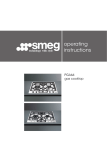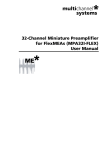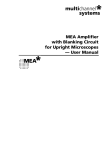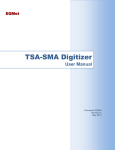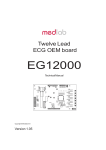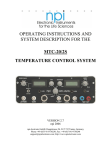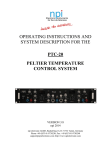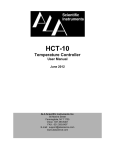Download 8-Channel Miniature Preamplifier User Manual
Transcript
8-Channel Miniature Preamplifier User Manual Information in this document is subject to change without notice. No part of this document may be reproduced or transmitted without the express written permission of Multi Channel Systems MCS GmbH. While every precaution has been taken in the preparation of this document, the publisher and the author assume no responsibility for errors or omissions, or for damages resulting from the use of information contained in this document or from the use of programs and source code that may accompany it. In no event shall the publisher and the author be liable for any loss of profit or any other commercial damage caused or alleged to have been caused directly or indirectly by this document. © 2002–2006 Multi Channel Systems MCS GmbH. All rights reserved. Printed: 2006-02-06 Multi Channel Systems MCS GmbH Aspenhaustraße 21 72770 Reutlingen Germany Fon +49-71 21-90 92 5 - 0 Fax +49-71 21-90 92 5 -11 [email protected] www.multichannelsystems.com Table of Contents 1 Important Information and Instruction 1 1.1 Operator's Obligations 1 1.2 Guaranty and Liability 1 1.3 Important Safety Advice 2 2 Welcome to the MPA8I 3 3 Setting Up and Connecting the MPA 4 3.1 General Setup Recommendations 4 3.2 Connecting Michigan Probes 5 3.3 Connecting 8-Trodes 9 3.4 Testing the Noise Level of the Setup 5 3.4.1 Setting up MC_Rack 6 3.4.2 Typical Results 7 4 Service and Maintenance 11 4.1 Cleaning the Connectors 11 4.2 Sterilization 11 5 Pin Layout 12 5.1 Power Supply 12 5.2 Input Connector 12 5.3 Output Connector (Male, Front View) 12 5.4 Test Model Probe 13 6 Contact Information 14 7 Ordering Information 15 7.1 ME Systems 15 7.2 Amplifiers 15 7.3 Accessories 16 7.4 Multielectrode Arrays 16 7 Technical Specifications Important Information and Instruction 1 Important Information and Instruction 1.1 Operator's Obligations The operator is obliged to allow only persons to work on the device, who • are familiar with the safety at work and accident prevention regulations and have been instructed how to use the device; • are professionally qualified or have specialist knowledge and training and have received instruction in the use of the device; • have read and understood the chapter on safety and the warning instructions in this manual and confirmed this with their signature. It must be monitored at regular intervals that the operating personnel are working safely. Personnel still undergoing training may only work on the device under the supervision of an experienced person. 1.2 Guaranty and Liability The General conditions of sale and delivery of Multi Channel Systems MCS GmbH always apply. The operator will receive these no later than on conclusion of the contract. Multi Channel Systems MCS GmbH makes no guaranty as to the accuracy of any and all tests and data generated by the use of the device or the software. It is up to the user to use good laboratory practice to establish the validity of his findings. Guaranty and liability claims in the event of injury or material damage are excluded when they are the result of one of the following. • Improper use of the device • Improper installation, commissioning, operation or maintenance of the device • Operating the device when the safety and protective devices are defective and/or inoperable • Non-observance of the instructions in the manual with regard to transport, storage, installation, commissioning, operation or maintenance of the device • Unauthorized structural alterations to the device • Unauthorized modifications to the system settings • Inadequate monitoring of device components subject to wear • Improperly executed and unauthorized repairs • Unauthorized opening of the device or its components • Catastrophic events due to the effect of foreign bodies or acts of God 1 8-Channel Miniature Preamplifier User Manual 1.3 Important Safety Advice Warning: Make sure to read the following advices prior to install or to use the device and the software. If you do not fulfill all requirements stated below, this may lead to malfunctions or breakage of connected hardware, or even fatal injuries. Warning: Obey always the rules of local regulations and laws. Only qualified personnel should be allowed to perform laboratory work. Work according to good laboratory practice to obtain best results and to minimize risks. The product has been built to the state of the art and in accordance with recognized safety engineering rules. The device may only • be used for its intended purpose; • be used when in a perfect condition. • Improper use could lead to serious, even fatal injuries to the user or third parties and damage to the device itself or other material damage. Warning: The device and the software are not intended for medical uses and must not be used on humans. • Malfunctions which could impair safety should be rectified immediately. • Any physical damage of the cable, such as a broken cable, causes a physical damage of the miniature preamplifier that cannot be repaired. • Protect the device from heat. Do not autoclave! • You can clean the connectors with distilled water in an ultra sonic bath, but keep the cable away from the fluid. Dry the device with compressed air. • Use and keep the device always in a dry environment. Do not expose it to fluids or vapor for a longer period of time. 2 Welcome to the MPA8I 2 Welcome to the MPA8I The 8-Channel Miniature Preamplifier MPA8I is connected to the microelectrodes for providing the initial tenfold amplification stage. It has additional common ground and reference electrode inputs. The reference electrode is ideally identical to the recording electrodes and placed into a comparable but inactive area or tissue. Background or noise signals that are picked up by both the reference electrode and the recording electrodes are removed. The metal case provides electrical shielding. Electrode damage is prevented by the very low bias current. The high input impedance ensures stable long-term recordings: Ideally, the input impedance would be infinite. As low voltages are generally recorded, a high current would flow if the input impedance were low. As a result, the amplifier would not be able to deliver the current, and the voltage would break down. The miniature preamplifier has a high input impedance to avoid this problem. Adapters for all standard microelectrodes such as Michigan probes (from the Center for Neural Communication Technology, University of Michigan) or the 8-Trode (from ALA Scientific Instruments Inc., New York) for acute and chronic implantations ensure a close proximity to the probe to minimize signal loss and cross talk. Adapters are not included in the standard scope of delivery and have to be ordered separately. For custom adapters, please ask your local retailer or contact Multi Channel Systems. 3 8-Channel Miniature Preamplifier User Manual 3 Setting Up and Connecting the MPA 3.1 General Setup Recommendations In the following, you find general recommendations for the installation. If you are using Michigan probe or 8-Trode adapters available from MCS, please refer to the following chapters for more information. Important: It is important that the complete setup refers to a single common ground. The reference input has always to be connected. It is recommended to use a reference electrode. However, if you are not using a reference electrode, connect the reference input to ground (GND). Otherwise, noise picked up by the reference input will be subtracted from the recording signals. This will either lead to signal loss or to a very high noise level. 1. Ground the animal with a ground electrode of large surface area, for example, a liquid gel adhesive electrode, that is connected to the ground of the setup, for example, a large metal table or a Faraday cage, to avoid pickup of noise from the environment. The ground electrode is best positioned in an electrically inactive region (not near muscle, nor heart), for example, at the belly. 2. Connect the GND input or the metal case of the miniature preamplifier to the common ground of the setup. (The GND input is internally connected to the metal case.) 3. Connect the reference electrode to the reference input of the miniature preamplifier. Generally, a reference electrode is inserted into non-active tissue of the experimental model. The reference electrode should be identical to the recording electrode so that both electrodes see the same background noise. This is necessary because despite the grounding, the animal’s body often has not exactly a potential of zero, due to the electrode impedance, for example. The background noise is then subtracted from the recording signal, increasing the signal to noise ratio. Please note that this may not work if the complete setup is not properly grounded. 4. Connect the recording electrodes to the recording channels of the miniature preamplifier. You can either use single electrodes or multitrodes with the miniature preamplifier. MCS provides adapters for standard probes. 5. Connect all unused recording channels to the REF input or to the reference electrode (or to the amplifier’s ground if that is not possible) to avoid noise pickup. As the total amplifier gain generally lies in the range of 1000, even very small noise signals may generate high noise signals. 4 Setting Up and Connecting the MPA 6. If you are not using a Faraday cage, it might be necessary to shield the complete setup with aluminum foil or similar to prevent electrical interference from the outside. Connect the aluminum foil to the ground of the setup (for example, the metal table). Troubleshooting: If you observe problems with noise, check that the ground of the setup is connected to exactly the same ground as the data acquisition computer. For example, connect the metal table to the ground/earth wire of a free power outlet (of the same electrical system), as the computer is generally connected to ground/earth via the power plug, too. Also, connect the data acquisition computer’s metal case with a thick ground wire to the ground of the setup (for example, the metal table), preferably with a 4 mm plug. 3.2 Testing the Noise Level of the Setup A termination plug that connects all inputs to ground, and a model test probe that mimics the electrode impedance are provided for testing the noise level of the setup.Please note that all instruments were thoroughly tested at the factory site before delivery. The suggested tests are mainly intended for optimizing and troubleshooting your setup, to exclude any damage that might have occurred during transportation, or to fulfill your own guidelines, for instance. It will take only a few minutes time and can save you time and trouble in the long run. Multi Channel Systems recommends running these tests before you start your real experiments. 1. Connect the termination plug to one MPA8I, and the model test probe to the other as shown in the picture (do not mismatch the polarity). If you have only one MPA8I, you can perform the two tests consecutively. 2. Connect the MPA8I with test model probe to channels 1–8 of the signal collector. 3. Connect the MPA8I with termination plug to channels 9–16 of the signal collector. 4. Make sure that all other connections are appropriate, and that your setup has an appropriate grounding and shielding as recommended in the chapter General Setup Recommendations. 5 8-Channel Miniature Preamplifier User Manual 3.2.1 Setting up MC_Rack Please refer to the MC_Rack User Manual for more information. 1. Start MC_Rack. 2. Open the file MPA8I_NoiseTest.rck on the installation volume (see folder Tutorial). This rack contains the virtual MC_Card instrument with a continuous raw data display and an Analyzer to measure the peak-to-peak amplitude. 3. Click Start to start the recording. — OR — Set up the rack on your own: 1. Click Set Channel Layout on the Edit menu. Select a 1-dimensional layout. Select the number of electrode channels (at least 16). 2. Add the MC_Card to your virtual rack. 3. In the tree view pane of the virtual rack, select the MC_Card, and click the Hardware tab. Enter the total amplifier gain according to the specifications of the instruments. For example, for a miniature preamplifier with a gain of 10 and a following filter amplifier with a gain of 100, the total gain is 1000. 4. Select an input voltage range of –819.2–818.8 mV and a sampling rate of 10000 Hz. 5. On the Edit menu, click Add Data Display to add a raw data display to your virtual rack. 5. In the virtual rack tree view pane, select the Display 1 and click the Layout tabbed page. Set up a channel map with channels 1–16. 6. Adjust the display ranges to 500 ms and +/–50 µV. 7. On the Edit menu, click Add Analyzer to add an Analyzer to the virtual rack. Select all or two typical channels on the Channels tabbed page. Select the Peak-Peak Amplitude parameter on the Analyzer tabbed page. 8. On the Edit menu, click Add Parameter Display to add a Parameter Display to the virtual rack. 9. In the virtual rack tree view, select the Display 2 and click the Layout tabbed page. Set up a channel map with all channels that were assigned to the Analyzer. 10. Click the Ranges tabbed page and enter 0–10 s for the x range and 0–100 µV for the y range. 6 Setting Up and Connecting the MPA 3.2.2 Typical Results Typical results of this test are shown in the following screen shot. The filter amplifier used for this test had a gain of 100 and a bandwidth of 0.5–5000 Hz (FA64I-100-0.5-5000). If you use a filter amplifier with a narrower bandwidth, you can generally expect a slightly lower noise level. Figure 1 Noise level test with MPA8I and FA64I-100-0.5-5000 filter amplifier. The noise level is 60 µV peak to peak with the provided test model probe (channels 1–8) and 20 µV peak to peak with grounded inputs (channels 9–16). The top window shows raw data; the bottom window shows the extracted peak-to-peak amplitudes of channels 1 and 9. (The miniature preamplifier was shielded by a metal case connected to the ground/earth of the test lab.) 7 8-Channel Miniature Preamplifier User Manual 3.3 Connecting Michigan Probes → Insert one pin array of the Michigan Probe adapter into one MPA8I, and the other into the second MPA8I. Make sure that the orientation of the MPA8I is correct (see illustration). The adapter’s ground input and reference input have been connected as factory-default settings. You can change this connection to meet your requirements, but make sure that the reference input is not open. 8 Setting Up and Connecting the MPA 3.4 Connecting 8-Trodes The 8-Trode adapter allows a direct connection of the 8-Trode (from ALA Scientific Instruments Inc., New York) for acute and chronic implantations to an 8-channel miniature preamplifier (MPA8I). → Connect the 8-Trode adapter to the miniature preamplifier on one side and to the 8-Trode on the other side. 9 8-Channel Miniature Preamplifier User Manual The MPA8I has two ground inputs. The two ground outputs of the 8-Trode-adapter are only required for connecting these two inputs to the ground of the adapter, they have no additional function. There is an optional 0 Ohm resistor that can be connected between the reference (R) input and output. If this is not the case (the standard state of delivery), the input is measured against the input of the R pin, that is, the noise measured with the R electrode is subtracted from the input signals of the 8 channels. It is possible to solder a 0 Ohm resistor onto the adapter. In this case, the reference input will be connected to ground, that is, all signals would be measured against the general ground of the setup. Please specify this option on your order. 10 Service and Maintenance 4 Service and Maintenance 4.1 Cleaning the Connectors Warning: Make sure that only the connectors touch the liquid; do not submerge the miniature preamplifier or the cable into cleaning solutions. Otherwise, you can fatally damage the electronics. It is recommended to avoid the use of aqueous cleaning solutions to avoid corrosion. If necessary, use distilled water. → Clean the connectors with 70 % alcohol and cotton swabs from time to time. → If this does not provide satisfying results, insert only the connectors into a small beaker with acetone or alcohol and sonificate for 10–20 s in an ultrasonic bath. Air-dry the miniature preamplifier for about 5 min before use. → You can clean the connectors with distilled water in an ultra sonic bath. Dry the connectors with compressed air immediately after sonification and let the amplifier air dry for at least 6 h before use. 4.2 Sterilization Warning: Do not autoclave or sterilize miniature preamplifiers by high heat (above 70 °C) or vapor. The resin is not heat-stable and may deform under heat. Vapor can lead to a corrosion of the electronics. Miniature preamplifiers can be sterilized with standard methods that are not based on high heat or vapor, for example, with 70 % ethanol, UV-light, or by thermal sterilization in an oven at 56 °C with an incubation time of 8 hours. 11 8-Channel Miniature Preamplifier User Manual 5 Pin Layout 5.1 Power Supply Supply voltage is applied to the output connector pins 8 and 15. The voltage source should supply a stable noise-free voltage. Do not exceed the maximum voltage. Pin 8: –3 V to –8 V Pin 15: +3 V to +8 V Warning: Do not mismatch the polarity of the power supply. A false connection may damage the unit. 5.2 Input Connector Please note that the black side is considered the top side. 1 Ground (GND) 2 Reference input 3 ... 10 Recording channels 1 to 8 11 5.3 Ground (GND) Output Connector 1 3 2 9 10 4 11 Connector 5 6 13 12 Cable 7 14 8 15 Output 1 1 Ground (GND) 9 2 Signal ground* 2, 10, 3, 11, 4, 12, 5, 13 3 ... 10 Recording channels 1—8 6, 14, 7 11 ... 13 Ground (GND) 15 14 Positive supply voltage 8 15 Negative supply voltage * = Connected to the ground of the amplifier. The signal ground is used as the reference for the following filter amplifier. 12 Pin Layout 5.4 Test Model Probe Test signal IN: You can use the jumper to connect the signal input pin (Signal IN) to ground (standard situation for a noise level test), or you can connect a data source, for example, a sine wave generator to the input (and the ground of the test signal to the signal ground input) to test the signal distribution. The input signal is distributed across all recording channels. REF IN: The standard situation in an experiment should be that the reference electrode has properties identical or close to the recording electrodes. You can remove the jumper to connect the reference output of the test model probe to the same resistors as the recording channels to mimic the experimental situation, or you can use the jumper to connect the reference output to ground. DC resistance Dynamic resistance Capacitance 4.7 MOhm 330 kohm 150 pF 13 8-Channel Miniature Preamplifier User Manual 6 Contact Information Local retailer Please see the list of official MCS distributors on the MCS web site. User forum The Multi Channel Systems User Forum provides an excellent opportunity for you to exchange your experience or thoughts with other users worldwide. Mailing list If you have subscribed to the ME-System mailing list, you will be automatically informed about new software releases, upcoming events, and other news on the product line. You can subscribe to the list on the MCS web site. www.multichannelsystems.com 14 Ordering Information 7 Ordering Information Please contact your local retailer for pricing and ordering information. 7.1 7.2 ME Systems Product Product Number Description Data acquisition system with 16 analog channels ME16 System Data acquisition system with 32 analog channels ME32 System Complete with data acquisition computer with MC_Card and IPS10W, and software package Data acquisition system with 64 analog channels ME64 System Data acquisition system with 128 analog channels ME128 System Amplifiers Product Product Number Description Miniature preamplifier with 2 electrode inputs MPA2I Miniature preamplifier with 8 electrode inputs MPA8I Small sized and light weight headstage with common ground and additional indifferent reference electrode input, input type I, gain = 10 Miniature preamplifier with 32 electrode inputs MPA32I Miniature preamplifier with 32 electrode inputs for use with FlexMEAs MPA32IFLEX Filter amplifiers with 4, 8, 16, 32, 48, or 64 channels and input type S or I FANNX NN is the total number of channels, X is the input type (S or I), with custom gain and bandwidth Amplifier with programmable gain, 16 channels PGA16 Gain programmable from 10 to 5000, with custom bandwidth Amplifier with programmable gain, 32 channels PGA32 Amplifier with programmable gain, 64 channels PGA64 Amplifier with programmable gain, 16 input and 32 output channels PGA1632 Amplifier with programmable gain, 32 input and 64 output channels PGA3264 Gain programmable from 10 to 5000, with two different custom pass bands 15 8-Channel Miniature Preamplifier User Manual 7.3 7.4 Accessories Product Product Number Description Michigan Probe adapters MP-ADPT-16 Allow a direct connection of Michigan probes to two miniature preamplifiers MPA8I. Available for 16, 32, and 64 channels. 8-Trode adapter 8-Trode adapter Allows a direct connection of the 8Trode from ALA Scientic Instruments Inc. to the MPA8I. Signal collector for 8 x MPA8I SC8x8 Collects the 8 channels from each of the up to 8 miniature preamplifiers MPA8I and leads them to the amplifier via a 68-pin MCS standard cable Signal collector with blanking circuit for 8 x MPA8I SC8x8BC Collects the 8 channels from each of the up to 8 miniature preamplifiers MPA8I and leads them to the amplifier via a 68-pin MCS standard cable, the voltage outputs are held constant during the TTL blanking signal, stimulus artifacts are avoided Power supply with 20 W power and +/– 7 V output voltage PS20W For supplying power to programmable gain amplifiers, for custom setups that lack an internal power supply, or for other custom applications Multielectrode Arrays Multielectrode arrays are not available from Multi Channel Systems, but from several other providers. The following are compatible with the miniature preamplifiers from Multi Channel Systems. If you are interested in a particular probe that is not mentioned here, please ask Multi Channel Systems or your local retailer for compatibility. Product Description Michigan probes 16-channel silicon probes NeuroNexus Technologies www.neuronexustech.com 8-Trode Electrodes with eight pads, for in vivo acute or chronic implantation ALA Scientific Instruments, Inc. www.alascience.com 16 Supplier Technical Specifications Date of Print: 23.11.2005 MPA Miniature Preamplifier MPA8I 0 °C to 50 °C 0 °C to 50 °C 10 % to 85 %, non-condensing 17 mm x 25 mm x 1.8 mm 1.3 g w/o cable and plug, 21 g with cable and plug 2 kg 2 kg Single-row precision sockets, 50 mil (1.27 Single-row precision sockets, 50 mil (1.27 mm) grid pattern, for 0.35-0.45 mm mm) grid pattern, for 0.35-0.45 mm round pins) round pins) MPA32I 0 °C to 50 °C 0 °C to 50 °C 10 % to 85 %, non-condensing 27 mm x 36 mm x 5 mm 7 g w/o cable and plug, 56 g with cable and plug 2 kg Dual-row precision sockets, 50 mil (1.27 mm) grid pattern, for 0.35-0.45 mm round pins) MPA32IFLEX 0 °C to 50 °C 0 °C to 50 °C 10 % to 85 %, non-condensing 27 mm x 34 mm x 5 mm 7 g w/o cable and plug, 56 g with cable and plug 2 kg Special input for use with FlexMEAs Supply voltage Supply current ± 3 V to ± 8 V DC < ± 2 mA, typically ± 1 mA ± 3 V to ± 8 V DC < ± 6 mA, typically ± 4 mA ± 3 V to ± 8 V DC < ± 14 mA, typically ± 9 mA ± 3 V to ± 8 V DC < ± 14 mA, typically ± 9 mA Number of input channels Input voltage Noise density 2 0 to 500 mV (with respect to a supply voltage of 5 V) 1012 Ω parallel to 10 pF < 1.5 µV RMS (1 Hz to 5 kHz, inputs shortcircuited) en = 15 nV / Hz 8 0 to 500 mV (with respect to a supply voltage of 5 V) 1012 Ω parallel to 10 pF < 1.5 µV RMS (1 Hz to 5 kHz, inputs shortcircuited) en = 15 nV / Hz 32 0 to 500 mV (with respect to a supply voltage of 5 V) 1012 Ω parallel to 10 pF < 1.5 µV RMS (1 Hz to 5 kHz, inputs shortcircuited) en = 15 nV / Hz 32 0 to 500 mV (with respect to a supply voltage of 5 V) 1012 Ω parallel to 10 pF < 1.5 µV RMS (1 Hz to 5 kHz, inputs shortcircuited) en = 15 nV / Hz Number of output channels Output voltage Output current Output impedance Bandwidth 2 = supply voltage max ± 10 mA 0Ω DC to 50 kHz 8 = supply voltage max ± 10 mA 0Ω DC to 50 kHz 32 = supply voltage max ± 10 mA 0Ω DC to 50 kHz 32 = supply voltage max ± 10 mA 0Ω DC to 50 kHz Gain 10 10 10 10 Operating temperature Storage temperature Relative humidity Dimensions (W x D x H) Weight Maximum tensile strength of cable Input connector type Input impedance Input noise MPA2I 0 °C to 50 °C 0 °C to 50 °C 10 % to 85 %, non-condensing 12 mm x 31 mm x 3 mm Versions with 2, 8 and 32 channels available, MPA2I, MPA8I, and MPA32I, respectively. MPA 32IFLEX is a special version for use with Flex-MEAs. Page 1 of 1 © 2003 Multi Channel Systems MCS GmbH





















